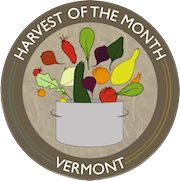A Sensory Exploration of Winter Squash
This month’s HOM Extension Lesson brought me to NewBrook Elementary in Newfane, Vermont, where I had the pleasure of delivering a sensory-packed winter squash taste test lesson with the invaluable support of Amy Duffy. Our goal was to guide K-5 students on an immersive journey through their five senses—sight, sound, smell, touch, and taste—all in celebration of the current Harvest of the Month: winter squash.
Newbrook Elementary students with Harvest of the Month Program Manager Devan Monette.
Setting the Stage
For the younger students, we kicked things off with a snippet from Freedom Soup by Tami Charles. The gentle storytelling of Belle and her grandmother preparing pumpkin soup introduced some examples of descriptive language. Lines like “Ribbons of stem dance up to the ceiling,” and “the pumpkiny-garlic smell swirls all around us” help paint a picture as to the joys of cooking while at the same time, building anticipation for the experience to come. For older students, we outlined how to make an observation. This framework sets the structure for students to share their observations using “I noticed…” statements, corralling the excitement that can stray off topic and setting a foundation for critical thinking.
Step 1: Seeing Squash
Our sensory adventure began with sight. Students examined a variety of squash types, including one sliced in half to reveal its bright orange interior. For an extra layer of engagement, I germinated squash seedlings beforehand—an easy precursor activity that can help build excitement in the days leading up to the lesson.
When it comes to sharing inquisitive takes on things adults may take for granted, kids never disappoint in coming up with truly unique and hilarious descriptions:
“It looks smooth, but bumpy.”
“That gourd has wings!”
“It’s yellow, green, orange, and bumpy.”
Each comment highlighted their budding ability to translate visual data into words.
Step 2: The Sound of Squash
Next, we focused on sound. Students closed their eyes as I played an ASMR-style food prep video featuring squash. The sounds of knives slicing, seeds scooping, and the satisfying thud of squash halves landing on the cutting board all stimulated students to make auditory observations— a new challenge to many! Many made connections from what they heard to what they thought they would see, but with a little guidance students were able to think solely around the textures, and compositions they heard and connect this to how they thought it might be to prepare and cook a squash.
Step 3: Smell the Difference
Then it was time to smell. Three jars circulated the room, each holding a different stage of squash: roasted, raw cubed, and seeds mixed in with fibrous strands. The students’ reactions were wonderfully pure and insightful:
“It smells like carving pumpkins.”
“This one smells like cantaloupe.”
“Hmm, this one smells sweet.”
In hindsight I would have loved to see how reactions would vary if the contents of the jar were kept secret. A simple covering around the outside of the jar could have helped deepen the experience and help strengthen students olfactory intuition.
Newbrook students smell different types of squash.
Step 4: Touching the Mystery Box
Now for the crowd favorite: touch. Out came the mystery box—a sensory classic from my mom’s teaching playbook. Inside were seeds and stringy squash innards. One by one, students plunged their hands into the gooey mess. All ages were eager to reach into the unknown and brave the experience with a smile. Although I think most students had an idea what was in the box, especially after the first few takers, the anticipation didn’t wane. The class sprung into excitement with comments like:
“Eww! Actually, I think I like it.”
“It’s cold and slimy!”
And of course, the room was full of giggles and all smiles.
With a little guidance, and a quick lineup for washing hands, cleanup was a breeze and the students were able to settle back into their seats for the grand finale.
Step 5: Tasting Time
Finally, the moment they’d all been waiting for: taste. With Amy’s help, we served roasted butternut and spaghetti squash samples. Armed with their Taste Test Passports, students rated flavor, texture, and overall preference. With the support of the handout, students were able to more finely hone their observational skills, challenging themselves to gauge exactly where the experience they were sensing fell on my simplified scales.
This last portion of the activity also set the stage for a follow-up project: creating a squash soup for their school’s harvest dinner. The winning squash would take center stage, giving students another chance to explore it—this time in a communal dish.
Newbrook students filling out their taste test passports.








